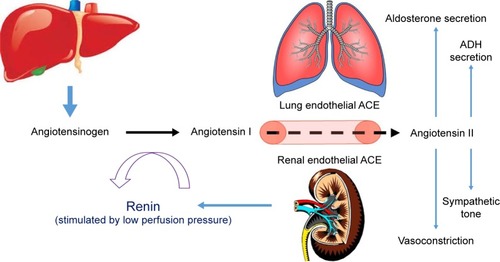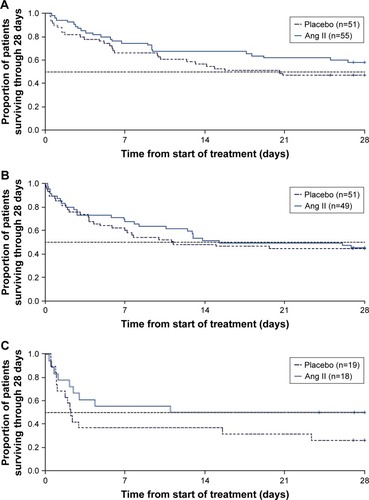Figures & data
Figure 1 The renin–angiotensin–aldosterone system.
Notes: Angiotensinogen originates in the liver, is cleaved to angiotensin I by renin in the kidney, and is further cleaved to angiotensin II by ACE, primarily in the lungs. Angiotensin II has a multitude of effects throughout the body, including modulation of sympathetic activity and electrolyte and free water homeostasis. It is also a potent direct vasoconstrictor and potentiates the release of both aldosterone and ADH.
Abbreviations: ACE, angiotensin converting enzyme; ADH, antidiuretic hormone.
Abbreviations: ACE, angiotensin converting enzyme; ADH, antidiuretic hormone.

Figure 2 Progressive Kaplan–Meier analysis of the mortality effect of Ang II in patients with ARDS.
Notes: Kaplan–Meier estimate of survival of patients enrolled in the ATHOS-3 study through day 28 by severity of ARDS. In ATHOS-3, patients were randomized to standard of care therapy plus either placebo or Ang II. A post hoc subgroup analysis of patients in ATHOS-3 with ARDS at enrollment showed that the observed mortality benefit of patients receiving Ang II was more pronounced with higher severity of ARDS. (A) Patients with mild ARDS at baseline. (B) Patients with moderate ARDS at baseline. (C) Patients with severe ARDS at baseline. Reproduced from Busse LA, Gong T, Thompson M. Outcomes in patients with acute respiratory distress syndrome receiving angiotensin II for vasodilatory shock. Critical Care. 2018;22(Suppl 1):82.Citation131
Abbreviations: Ang II, angiotensin II; ARDS, acute respiratory distress syndrome.
Abbreviations: Ang II, angiotensin II; ARDS, acute respiratory distress syndrome.

Table 1 Current and contemplated uses of Ang II
